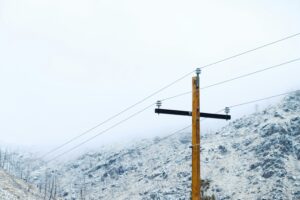Even nonprofessionals can perform a routine electrical home inspection from time to time. It just takes a little know-how and a willingness to learn a few fundamentals.
Of course, it’s important to remember that only an electrician can perform a thorough electrical inspection of your home. Standard inspections can cover a lot of ground, and property owners themselves can perform basic reviews and checkups, which we cover below.
However, a trained and expert eye will almost certainly provide you with the best and most comprehensive home electrical inspections.
For example, you may have wiring that needs to be replaced; perhaps it’s functioning properly at the moment, but as it degrades further, it could lead to an electrical fire.
When in doubt, contact Prairie Electric. Our talented, experienced, and licensed electricians are happy to help. They’ll pinpoint problems and the reasons for those problems right away. They’ll also be able to forecast problems that may crop up in the future.
And now … your Electrical Home Inspection Checklist!
Electrical Inspection Checklist For The Home
Here are a few things you can do on your own. Think of it as a professional electrical safety checklist for amateurs!
✔️ Electric Meter
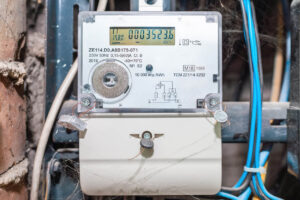
Check:
✓ Installation
✓ Cracks
✓ Water damage
✓ Rust
Your electric meter is usually an efficient and trouble-free mechanical marvel. It spins merrily along, calculating your energy usage and displaying it analog-style for the monthly visit from the meter reader. (In the case of smart meters, which are becoming more and more common, the meter delivers the information directly to your power company.)
Still, everything is susceptible to a glitch. Homeowners can perform an eyeball test on their meter to ensure that it’s working. They can also examine the meter for physical defects that may impair its proper functioning.
Is the meter still installed correctly? Is anything cracked or broken? Does the box or meter itself show signs of water damage or rust?
✔️ Circuit Breaker
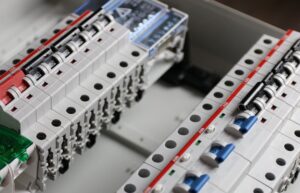
Check:
✓ Tripped breakers
✓ Corrosion
✓ Moisture
The circuit breaker is part of what’s also known as the circuit box, breaker box, electrical panel, or (even though fuses are less common than they once were), the fuse box.
Examine the circuit breaker to make sure nothing’s been tripped. This is usually the first thing one does when a portion of a home has lost power. Hair dryers and other appliances can sometimes cause the circuit breaker to trip and cause that loss of power.
Most homeowners and renters are aware of the need to check the box when something has tripped. But circuit breakers can also be checked for signs of corrosion or moisture, especially in older homes or if the breaker is located in basements or near washers and dryers or bathrooms and showers.
✔️ Electrical Wires
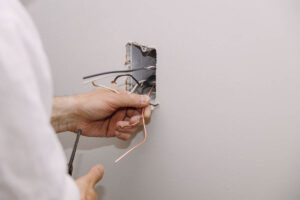
Check:
✓ Frayed wires
✓ Hanging wires
✓ Loose wires
This may be the most straightforward inspection of all. Wires are usually out of sight (and out of mind). An electrician can search for frayed or damaged wires in walls or other places behind the scenes.
But if you’ve just moved into a new home, you may notice wires hanging in attics, crawl spaces, or down in the basement. If that’s the case, contact an electrician to design a safer and more efficient method of wiring.
✔️ Overloaded Power Strips
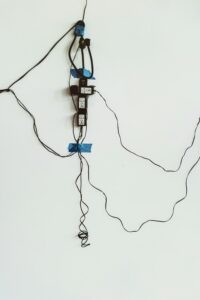
Check:
✓ Too many plugs in one outlet
✓ Power strips plugged into other power strips
✓ Appliances that require a dedicated outlet
Remember the scene in “A Christmas Story” where the old man has about a dozen things plugged into a single wall outlet? We’ve come a long way since then; power strips and surge protectors are light years ahead of their old counterparts, but they still have their limits.
Make sure that none of the power strips in your home are plugged into other power strips that are plugged into other power strips — so on and so forth.
Also, be sure that nothing inappropriate is plugged into a power strip. Bob Vila lists a number of items that require their own dedicated wall outlet: big appliances, microwaves, hair dryers, and more. Take a look and make sure that nothing on Bob’s list is also plugged into your power strip.
✔️ Electrical Plugs
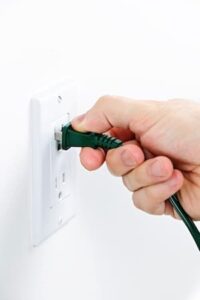
Check:
✓ Missing insulation covers
✓ Broken housings
✓ Bent prongs
✓ Missing prongs
✓ Enough space
✓ Snug fit
✓ Permanently used extension cords
There’s an impressive number of safety features built into a modern electrical plug. Examine them from time to time. Look for missing insulation covers, broken housings, and bent or missing prongs. With damaged safety features, the likelihood of sparking and electrical fires increases.
Also look out for plugs that are smashed against the wall because they’re located behind large items of furniture, such as your living room sofa. Plugs need space to operate and function properly, so make sure they have breathing room back there. The plug should fit snugly. And the cord should never be bent so severely that one risks damage to the rubber housing or the wires within.
Check your extension cords, too. And remember: Don’t use an extension cord as a permanent power supply. If you need additional electrical outlets, get in touch with an electrician.
Prairie Electric
According to FEMA, there were 25,700 residential fires in 2018 that were caused by electrical malfunction. While this represents a slight decrease in electrical malfunction fires over a 10-year period, it’s still a pretty significant number.
Let’s all do our part to keep that house fire number on a downward trajectory. Consider the tips listed above a first-line of defense against fire hazards. Contact Prairie Electric with any questions or concerns about safety inspections or the potential safety issues arising from DIY electrical projects.
We look forward to speaking with you and partnering with you to keep your electrical service flowing and your electrical system in tip-top shape.

